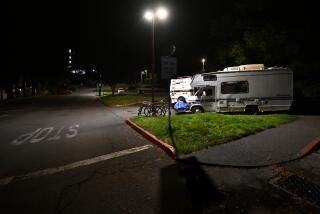Baled Out
- Share via
Bill was riding the baler, Jana was driving the loader and Russ had wagon duty. So Pat O’Brien rolled a 110-pound bale into the shade and sat down to talk about harvesting hay.
Enough hay to feed Pierce College’s small herd of cattle. And the horses. And the sheep. And then some. Twenty-five hundred bales, worth about $25,000--money the school doesn’t have, for an agriculture program that has been slowly withering for years.
O’Brien, a retired aerospace engineer from Redondo Beach with a yen to become a farmer, somehow took it upon himself to become the San Fernando Valley school’s white knight, planting and raising a crop of hay for the financially troubled institution’s animals.
“I think there’s a very good chance that if we hadn’t started the hay program . . . they’d have done away with the cattle,” O’Brien said.
The hay program--which is less a program in the academic sense than it is a bunch of aggies trying to keep the college farm afloat--was launched by O’Brien in late 1996.
Despite a rebounding economy, the Los Angeles Community College District was once again struggling financially, with Pierce among the most troubled of its nine campuses.
Things had gotten so bad, the college administration decided that the school could no longer afford to irrigate several pastures used to graze livestock--animals studied and cared for by the school’s small crop of future farmers, ranchers and veterinarians.
After 37 years with Hughes Aircraft, O’Brien wasn’t about to let the school’s self-imposed drought dry up his dream. He planned to study farming for a few years, then buy a little place away from the city, raise a few beef cows and watch the wheat grow.
So the 60-year-old with an MBA from Cal State Dominguez Hills floated a proposal: plant the fields with hay and dry-farm them, relying on only the rain for irrigation, and himself and Pierce farm employees Russ Schrotenboer, Bill Lander and Jana Sorensen for the labor.
The agriculture department agreed to lay out $3,620 for oat, barley and vetch seed, some baling wire and other necessities. And when the hay came up in the spring of 1997, O’Brien borrowed a swather and a baler from Cal Poly Pomona and gathered 89 tons of hay, worth $13,380.
“It was a good deal, so of course they let us do it again this year,” said O’Brien, who rises at 4:30 a.m. to make the drive from Redondo Beach in time for sunrise on the farm.
But last year was a pretty average year, weather-wise, producing a nice, if average, crop of hay.
This has been an El Nino year, and the rains, it seemed, would never end. Too much rain, as any hay grower knows, can be a big problem.
“A month ago, I was crying, ‘The sky is falling,’ ” O’Brien said.
In one field, no grain was coming up. Instead, a plant called mallow was flourishing. Figuring that field was a loss, the group let the cows graze on the mallow leaves, then mowed the stalks. But the rains kept falling, and up came the grains after all.
So they had hay, almost half again as much as last year. But Cal Poly Pomona couldn’t loan its equipment, so O’Brien turned to his brother, John O’Brien, with the Los Angeles County Sheriff’s Department, which loaned the equipment.
It probably isn’t the best hay ever harvested. There are more weeds in the bales than O’Brien would like. But all in all, this has been a fine lesson in old-fashioned, things-go-wrong farming.
“If the school was at its peak, I think I’d have gotten a Pollyanna view of farming,” he said. “Instead, I’m getting a realistic view.”
More to Read
Sign up for Essential California
The most important California stories and recommendations in your inbox every morning.
You may occasionally receive promotional content from the Los Angeles Times.













